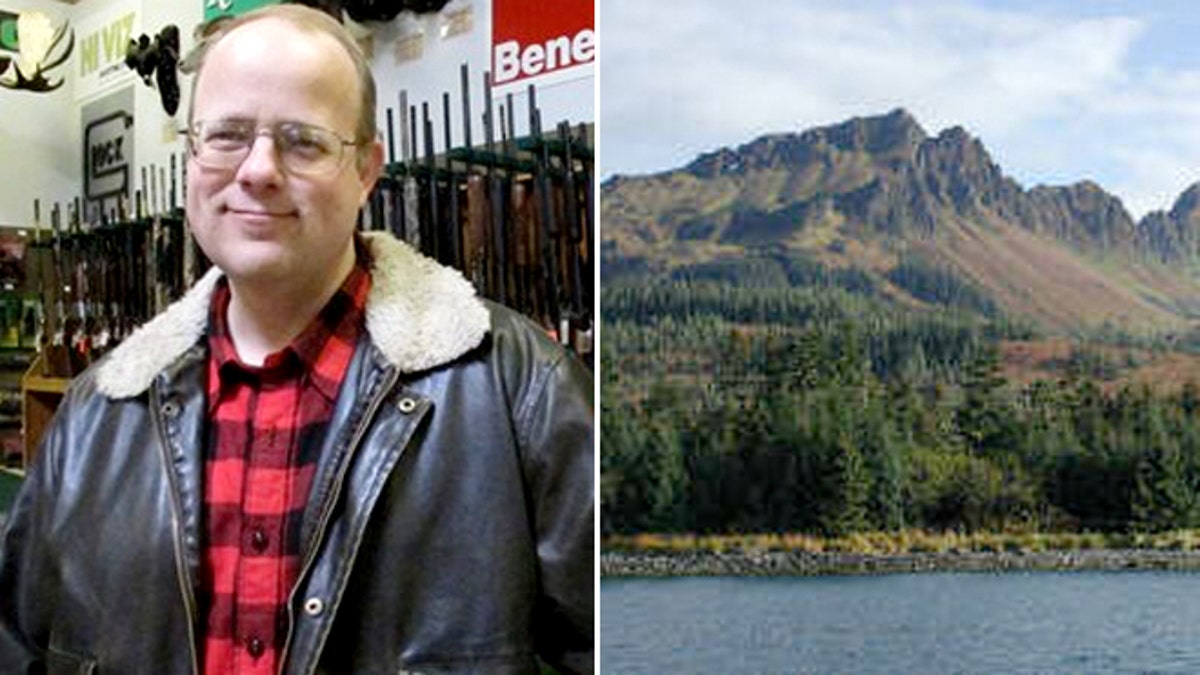
May 7, 2012: Charles Baird plans to live on Latouche Island in Alaska's Prince William Sound for a year homesteading and filming his adventure. (AP/NOAA)
Charles Baird is going off the grid for a year.
The 40-year-old oil company employee and filmmaker from Anchorage will move to the mostly uninhabited Latouche Island in Alaska's Prince William Sound at the end of May, completing a dream he's been contemplating for 17 years.
Baird will build a 12x12 shed to shelter him from the elements, and he plans to hunt and fish and fend off an occasional black bear during his sojourn to the Alaska wilderness.
He'll be incommunicado, only allowing himself to send short messages out via a satellite uplink to http://www.facebook.com/AlaskanPioneer and no way to receive any in. He won't even know who won the November presidential election for six months. He calls his experiment more modern-day homesteading than a survival game, but he's heading into the adventure well-armed.
"I may see some hunters and fishermen come by but otherwise I will be on my own, just me and my dog," he said.
Latouche Island is a narrow strip of land (12 miles long, 3 miles wide) located about 100 miles southwest of the port city of Valdez. Like many islands in Prince William Sound, people digging into the beach there can still find oil from the 1989 Exxon Valdez spill.
The now abandoned Latouche city site once was home to 4,000 people, thanks to copper mining. The mine closed in 1930, and now the island is dotted with occasional seasonal cabins and not much else. The island is mostly used for subsistence hunting.
Kate and Andy McLaughlin live in Chenega Bay, a village six miles away on Evans Island, and own a cabin on Latouche.
Kate McLaughlin doesn't know Baird, but has heard his story many times. In fact, she's written a book about people coming to Alaska to live the remote lifestyle and is in the process of trying to find a publisher.
"We've seen several people of his ilk try to come out and say, 'We're going to build a cabin, we're going to live out here and do it,'" she said. "It's tough."
Some abandoned supplies from those people making earlier attempts can still be found strewn on the beach.
The challenges of Latouche Island are numerous, and foremost is the weather.
"You're fighting the cold or the mold," McLaughlin said of the seemingly constant precipitation, snow and rain.
Baird said the island has anywhere from 80-120 inches of snow in a typical winter, along with 70 inches of rain a year.
The McLaughlins' two-story cabin on the beach had snow up to the roof this winter.
"It's wet, things don't dry out," said Dave Janka, who owns Auklet Charter Services in Cordova. "You get lots of snow."
Much like Cordova, he called Latouche Island "paradise with rain."
"Heavy weather is going to be a constant companion," said RJ Kopchak, a Cordova businessman and former commercial fisherman. "That's what happens there."
Another problem? Black bears. There's a large bear population on the island, and McLaughlin says they "love to get into trouble."
Baird said he'll be safe from the bears. He'll carry a .44 with him at all times, has a shotgun "and a few other weapons, as well." The dog will also alert him to any predators.
There are building restrictions on the uninhabited island, Baird said, so he will have to construct his makeshift cabin without digging into the ground for a foundation.
He plans to have lumber delivered to build his cabin, which will be located about a third of a mile from the beach, about 150 feet up a hill.
He'll have plentiful fishing opportunities.
"The nice thing about the ocean is twice a day you've got a dinner table set out for you," Janka said.
The challenges don't faze Baird, who is ex-military, except perhaps for one.
"Probably the biggest challenge is the isolation," he said, adding it was an issue for some of his classmates in an Air Force Academy survival training course.
Some "did experience hallucinations and even group delusions, just minor things. But it is kind of a concern, being alone that long," he said.
He said he's worked with psychologists at Harvard and the University of Chicago, talking through the things he can expect, like nightmares.
"I think I'll be OK, I've done a lot of work on my own, and I'll also have a dog, which probably will help keep things stabilized," he said.
He also plans to keep busy by reading, taking a couple thousand books on an electronic reader. He'll keep it charged with wind and solar systems he's taking with him.
Baird is planning to keep a diary, which could be turned into a book. He's also thinking of writing an instructional book of how to live in the remote wilderness.
Then there's also the filming, day in and day out, of his experiences alone on the Alaska island.
Once he returns to civilization, he'll edit the video and try to sell it as a documentary series.
Baird is not the first to make or film such an odyssey.
Dick Proenneke lived alone in a remote cabin and kept journals published as the classic Alaska memoir "One Man's Wilderness."
He moved to his cabin in 1968 at the age of 52. Proenneke lived alone until 1998 in what is now Lake Clark National Park and Preserve. He also filmed his adventures, which have been turned into DVDs and were aired on PBS. He died in 2003.




















